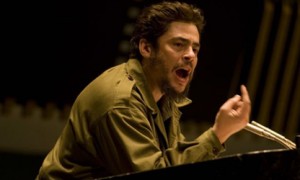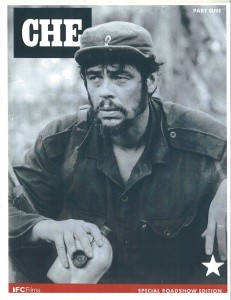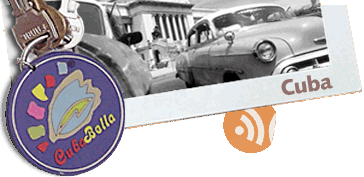Hollywood Filmmaker Steven Soderbergh’s “Che” Saga Hits U.S. Movie Screens
For those passing by certain filmhouses in New York City and Los Angeles, they would have noticed long lines of enthusiastic filmgoers waiting to see the movie about Argentine revolutionary Che Guevara that Hollywood filmmaker Steve Soderbergh made recently. The film, which is over 4 hours long, has been broken up into two parts.
The first part (“Che 1” — originally known as “El Argentino”) focuses on how Che met up with Fidel Castro in Mexico in 1956, which included their fateful clandestine trip to Cuba aboard the yacht “Granma” — a boat trip that launched Cuba’s revolutionary struggle against the then-Batista regime. That film detailed Che’s successful efforts to putting together a rebel army in Cuba’s mountainous eastern provinces. Interestingly, the beginning of “Che 1” and other portions of that film center around his speech at the United Nations in New York City in 1964, as well as his speaking to American reporters at a high society function there. The second part of that film, “Che 2” (a.k.a. “Guerrilla”) details his failed efforts to stir up revolution in Bolivia, amidst a climate and culture far apart from tropical Cuba.
The “Che” film was already showcased at the Cannes Film Festival in France, with Puerto Rican actor Benicio del Toro (who played Che) winning the Best Actor Award there, with the film attracting a respectable ensemble of actors to take part in the film. Even Hollywood actor Matt Damon took on a small role in the movie. “Film Comment” magazine mentioned that it was already pre-sold to the international film markets for US$54 million. That covered most of the film’s budget of US$58 million. Because of its controversial subject matter, Soderbergh had to seek financing outside of Hollywood to complete this film, namely the French production company Wild Bunch (which put up the majority of the funding), as well as Telecinco/Moreno Films of Spain. That explains why Soderbergh has chosen to do a limited run of the Che film in the USA. IFC Films, which acquired the North American rights to the Che film, is only showing it at so-called independent “art film houses” in NY and Los Angeles, as well as at its own movie house in NY. IFC will also be showing it on its own pay-per-view channel.
Despite the film’s length, I strongly recommend people see it — be it at the theater, pay-per-view (where available), or at the very worst on DVD. The film is very engaging, and gives viewers much context as to how Che lived his life. It will also give all those college kids who have been wearing Che’s t-shirt an opportunity to see who Che really was, and explain the man behind the image (especially that from the Korda snapshot of him known the world over).
The film is not without its criticism. As Cuban exiles in Miami and elsewhere would readily point out, it skips over Che having many anti-Castro individuals executed during the early days of the revolution. This is an important point in reference to the movie. In “Che 2”, when he was captured by both the Bolivian Army and members of the U.S. Special Forces sent to pursue Che and his band of fighters, one of the Special Forces members was a Cuban exile who asserted that Che previously had one of his relatives killed. Soderbergh’s omission of these details may help explain why the Cuban government had no problem letting the film be screened there. Click link to “Granma” article on Havana screening of the “Che” film last month:
http://www.granma.cu/INGLES//2008/diciembre/juev11/che.html
Perhaps for both budgetary reasons, and the fact that the film was alreadly too long, it also skipped over Che’s time in the Congo (1965), where he also tried (and failed — due mainly to the poor discipline of the Congolese rebels at the time) to stir up revolution there as well.
One issue that at least some people will wonder about is the the commercialization of “Che” (through the film, as well as the merchandising of t-shirts, posters and other souvenirs bearing his image) and who’s profiting from it — a topic worthy of further examination. One of the ironies of Che is how he has become a commercially successful icon and brand (of sorts), despite the fact that he fought ardently against Capitalism.
(Note: Cover page from program given out to moviegoers at “Che” screening in “IFC Center” movie theater in New York)





